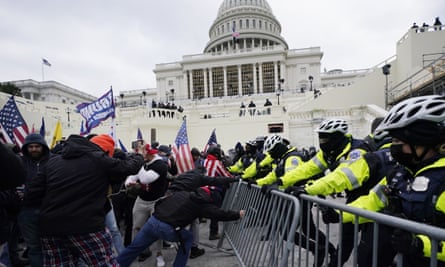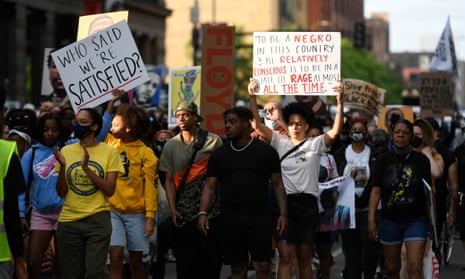The idea that all bias is some deviation from an unbiased center is itself a bias that prevents pundits, journalists, politicians and plenty of others from recognizing some of the most ugly and impactful prejudices and assumptions of our times. I think of this bias, which insists the center is not biased, not afflicted with agendas, prejudices and destructive misperceptions, as status-quo bias. Underlying it is the belief that things are pretty OK now, that the people in charge should be trusted because power confers legitimacy, that those who want sweeping change are too loud or demanding or unreasonable, and that we should just all get along without looking at the skeletons in the closet and the stuff swept under the rug. It’s mostly a prejudice of people for whom the system is working, against those for whom it’s not.
I saw a tweet the other day that said the Secret Service and US Capitol police must have been incompetent or complicit to be blindsided by the 6 January insurrection. The writer didn’t seem to grasp the third option: that the Secret Service was unable to see past the assumptions that middle-aged conservative white men don’t pose a threat to democracy and the rule of law, that elected officials in powerful places weren’t whipping up a riot or worse, that danger meant outsiders and others. A decade ago, when I went to northern Japan for the first anniversary of the Great Tōhoku Earthquake and tsunami, I was told that the 100ft-high wave of black water was so inconceivable a sight that some people could not recognize it and the danger it posed. Others assumed this tsunami would be no bigger than those in recent memory and did not flee high enough. A lot of people died of not being able to see the unanticipated.
People fail to recognize things that do not fit into their worldview, which is why those in power have not adequately responded to decades of terrorism by white men – anti-reproductive-rights-driven killings, racial violence in churches, mosques, synagogues and elsewhere, homophobia and transphobia, the pandemic-scale misogynist violence behind a lot of mass shootings, attacks on environmentalists, and white supremacy in the ranks of the police and the military. Finally, this year the US attorney general, Merrick Garland, called this terrorism by its true name and identified it as “the most dangerous threat to our democracy”. The constant assumption has been that crime and trouble comes from outsiders, from “them”, not “us”, which is why last summer’s Black Lives Matter protests were constantly portrayed by conservatives and sometimes the mainstream as far more violent and destructive than they were and the right has had such an easy time demonizing immigrants.
What violence and destruction did take place in or adjacent to Black Lives Matter protests was often the work of the right wing. That includes the murder of a guard at a federal court in Oakland, allegedly by an air force sergeant and Boogaloo Boy, while a BLM protest was going on nearby. It also reportedly includes some of the arson in Minneapolis shortly after George Floyd’s murder, as well as attacks on protesters. USA Today reported 104 such attacks by cars driven into crowds, many of them apparently politically motivated.
No one has ever loved the status quo more than the editorial board at the New York Times, which recently composed an editorial declaring it a misstep for “the city’s Pride organizers … to reduce the presence of law enforcement at the celebration, including a ban on uniformed police and corrections officers marching as groups until at least 2025”. They found a lesbian of color who is also a cop and focused on this individual feeling “devastated”, rather than the logic behind the decision. Pride celebrates the uprising against longtime police violence and criminalization of queerness at the Stonewall Bar in 1969.
Police officers are in no way banned from participating out of uniform, if they so desire, but that’s not enough for these “can’t we all get along” editorialists, who also wrote: “But barring LGBTQ officers from marching is a politicized response and is hardly worthy of the important pursuit of justice for those persecuted by the police.” You want to shout that the whole parade is political, because persecution and inequality have made being LGBTQ political, and the decision to include the police would be no less political than to exclude them. And who decides what’s worthy? The idea that there is some magically apolitical state all should aspire to is key to this bias and to why it refuses to recognize itself as a bias. It believes it speaks from neutral ground, which is why it forever describes a landscape of mountains and chasms as a level playing field.

The status-quo bias is something I’ve encountered over and over again as gender violence, particularly as the refusal or inability to recognize that a high-status man or boy, be he film mogul or high-school football player, can also be a vicious criminal. Those who cannot believe the charges, no matter how credible, often dismiss and blame the victim instead (or worse: reporting a rape too often leads to death threats and other forms of harassment and intimidation intended to make an uncomfortable truth go away). Society has a marked failure of imagination when it comes to grasping that such predators treat their low-status victims in secret differently than their high-status peers in public, and that failure of imagination denies the existence of such inequality even as it perpetrates it.
It’s a failure born out of undue respect for the powerful. (Here I think of all the idiots who kept discovering “the moment Trump became presidential” over and over again, unable to comprehend that his incompetence was as indelible as his corruption and malice, perhaps because their respect for the institution inexorably extended to the grifter who barged into it.) Centrist bias is institutional bias, and all our institutions historically perpetrated inequality. To recognize this is to delegitimize them; to deny it is to have it both ways – think yourself on the side of goodness while insisting no sweeping change is overdue. A far-right person might celebrate and perpetrate racism or police brutality or rape culture; a moderate might just play down its impact, past or present.
To recognize the pervasiveness of sexual abuse is to have to listen to children as well as adults, women as well as men, subordinates as well as bosses: it’s to upend the old hierarchies of who should be heard and trusted, to break the silences that protect the legitimacy of the status quo. More than 95,000 people filed claims in the sexual-abuse lawsuit against the Boy Scouts of America, and what it took to keep all those children quiet while all those hundreds of thousands of assaults took place is a lot of unwillingness to listen and to shatter faith in an institution that was itself so much part of the status quo (and in many ways an indoctrination system for it).
Centrists in the antebellum era were apathetic or outright resistant to ending slavery in the US and then in the decades before 1920 to giving women the vote. The civil rights movement was not nearly as popular in its time as moderates who like the more polite quotes from Martin Luther King Jr think it was. King himself famously declared, “I have almost reached the regrettable conclusion that the Negro’s great stumbling block in his stride toward freedom is not the White Citizen’s Counciler or the Ku Klux Klanner, but the white moderate, who is more devoted to ‘order’ than to justice; who prefers a negative peace which is the absence of tension to a positive peace which is the presence of justice …” As King notes, the status quo is always changing, and the centrists are often resistant to change that expands rights and justice, more mild about efforts by the right to shrink those things in favor of more inequality and more authoritarianism.
A recent study seems to contain the same biases, asserting, “We measured the brain activity of committed partisans watching real political video footage. Although all participants viewed the same videos, brain responses diverged between liberals and conservatives, reflecting differences in the subjective interpretation of the footage. This polarized perception was exacerbated by a personality trait: intolerance of uncertainty.” The research seems to assume that many at either end of the spectrum hold strong beliefs and are intolerant of uncertainty, but who is more intolerant of uncertainty than those who want to believe that authority is trustworthy, no secrets need sunlight, and urgent change is unwanted?
Another fallacy of the centrist stance is that right and left are symmetrically extreme. Leftwing violence is largely a failed experiment that faded away in the 1970s. Also, in recent years the strongest voices on the left have mostly told important truths and those on the right have promulgated lies while arguing against basic human rights. One obvious example is all the falsehoods about abortion used to justify undermining abortion access. Another is the conversation around the climate crisis. Activists and scientists have been saying for a long time that we’re in a dire situation that demands profound change. Yet the call for change is painted as extreme – rather than as the necessary response to an extreme planetary crisis. On the right, the call has been for inaction and denial of the science. This week the International Energy Agency belatedly got on board with what climate groups have been insisting on for years: an end to new fossil fuel exploration and extraction, a major shift now recognized as a reasonable and necessary one to preserve a liveable planet.
Was it radical to be correct too soon? What gets called the left is often just ahead of the game, when it comes to human rights and environmental justice; the right is often denying the existence of the problem, whether it’s pesticides and toxic waste or domestic violence and child abuse. There is no symmetry. A lot of what are now considered moderate – AKA centrist – positions were seen as radical not long ago, when this country supported segregation, banned interracial marriages and then same-sex marriages, prevented women from holding some positions and queer people from others, and excluded disabled people from almost everything. The center is biased, and those biases matter.
Rebecca Solnit is a Guardian US columnist. She is also the author of Men Explain Things to Me and The Mother of All Questions. Her most recent book is Recollections of My Nonexistence

